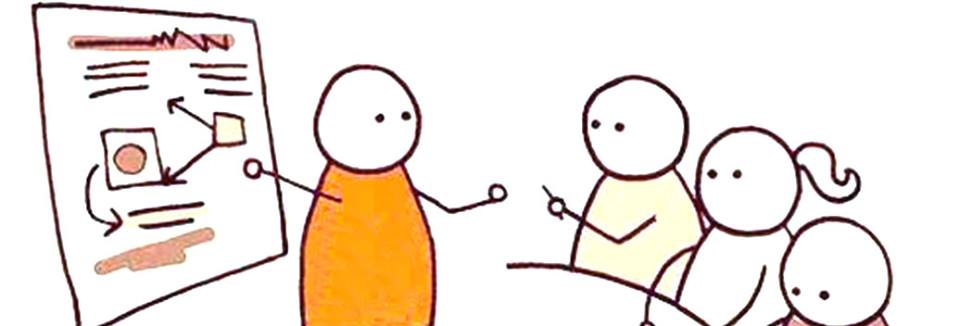Project Management: How to collect requirements for your project effectively?
Collecting requirements for a project is a very vital part. In fact, collect requirements process helps to define project scope during scope management. There are some set of tools and techniques to gather project requirements. It seems practical to collect all requirements at the start using a requirement-gathering tool. This should ensure the project deliverable as sought. But in reality, it is more challenging in present scenario – Why? The reason is, today’s scenario is dynamic in nature. Needs and requirements of project stakeholders change frequently. So, it's a responsibility of Project-manager (PM) to ensure capturing all the requirements. PM needs to be very agile while collecting requirements. To do so, PM should use appropriate requirement gathering tools during the project life. PM needs to be wise in the selection of the requirements tools. PM would ensure not to miss any requirement in the project outcome. Because, in the end, PM is liable for the success of the project. Consider yourself and ask these questions.
- How many projects have you not been able to succeed due to requirement issues?
- Have you faced challenges in gathering project requirements?
- How well are you in translating stakeholders’ all needs into project deliverables?
- Do you always use your favorite requirement collection technique irrespective of situation?
In this article, you'll understand requirements gathering techniques in detail. You’ll be able to select right tool at right time.
Project Management Collection requirement process:
Project Requirement:
Let’s first define Requirements in a Project. The requirement is the expectation of project stakeholders on project outcomes. As per the definition is given by PMI,
“Collect Requirements is the process of determining, documenting, and managing stakeholder needs & requirements to meet project objectives."
Hence, in Collection requirement process, the first step is to identify stakeholders’ needs. Second, Document these needs & requirements. And then, manage them throughout the project to meet project goals. This process forms the basis for project scope definition. This process contributes to the success or failure of a project. As per PMI, about 70% project’s failure is attributed to requirement collection. Also, this failure ranges from 50% to 70% depending on industry and type of project. A shocking fact, most of these projects were meeting schedule & budget criterion well. Product conflict was observed during final project delivery or project closure phase. Where project product couldn’t meet stakeholder’s requirements. So, now you can imagine, how much impact this process has, on project success!
Project Management tools and techniques for requirement gathering:
For any project success, project result must meet stakeholder’s needs and expectations. Capturing all project management requirements keeps you one step closer to project success. To collect requirements project PMBOK 6th Edition suggests project management tools and techniques.
Prerequisites for project management process tools and techniques on requirement collection;
Follow along below bullets, before deciding which tool to use:
- What are technical requirements for project management
- How to collect requirements for a project
- Go through the below tools and techniques of project management notes
PMBOK 6th Edition defines following techniques under section 5.2 Collect Requirements:
- Expert Judgment
- Data Gathering
- Data Analysis
- Decision Making
- Data Representation
- Interpersonal & Team Skills
- Context Diagram
- Prototypes
Let’s discuss these PMBOK tools in detail:
1. Expert Judgment:
Experts are the people more knowledgeable in their respective areas. Their knowledge & experience help to gather most of the specific product/ project requirements. Expert judgment is used to determine specialized requirements comprising following topics:
- Requirements elicitation
- Requirements analysis
- Business analysis
- Diagramming techniques
- Facilitation
- Conflict Management
- Projects requirements in similar previous projects
2. Data Gathering:
Data gathering is an important technique for facilitation &/or group creativity. Here, a group of people involves figuring out all project requirements. Ideas evolve through group creativity and help to determine requirements. There are several tools, we can use this technique. But the right selection depends on the type of needs or stakeholders including other complexities. Below is the list of tools under this technique:
a) Questionnaires and Surveys:
We use this requirement-gathering tool for large groups. Wherever there is a need to capture the requirements from various stakeholders. A large number of stakeholders doesn’t permit to arrange a one-to-one interview. Also, it’s not wise to call all them at one place, if they sit remotely. So, Questionnaire & Surveys give the opportunity to collect requirements of a big group of stakeholders. It also provides flexibility to stakeholders to take part as per their ease. Yet, to prepare the survey questions is another challenge, you have to be very careful about. Framing right/ relevant questions remove bias & help to collect real needs of stakeholders. Refer Figure 1 below:
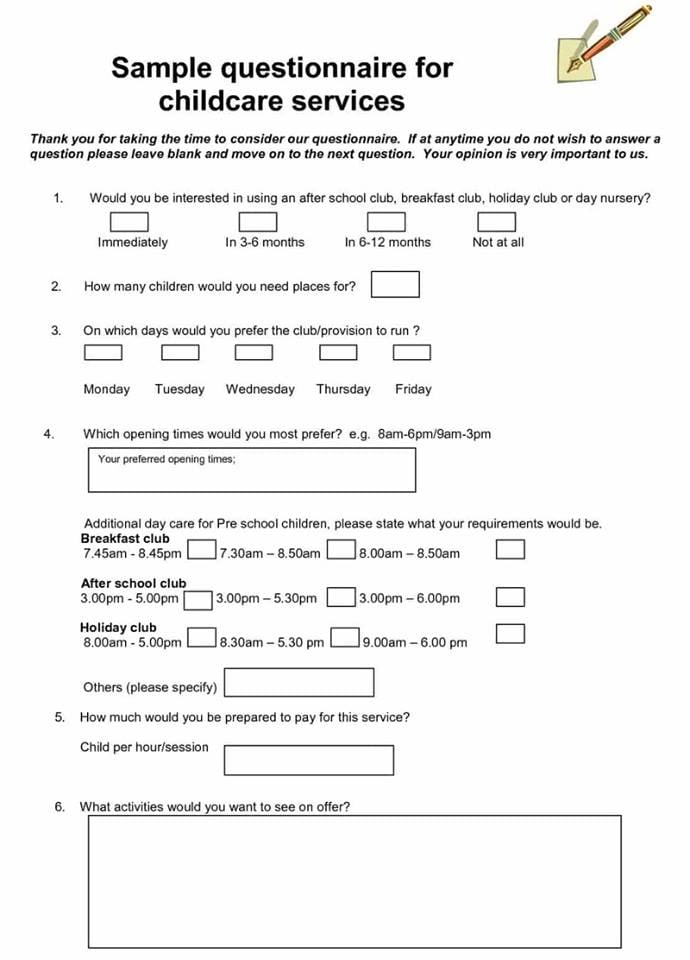
Image Source: https://sweetbook.me
Figure 1: Sample questionnaire to gather requirements in Childcare services
b) Interviews:
A tool to engage personally with stakeholders to understand needs. Interviews can be facilitated through personal meetings or phone calls. It’s a good practice to prepare a checklist before interviewing. This will ensure to capture all the requirements in a single meeting. Interviews can be elaborative; hence gives an opportunity to understand stated or unstated needs.
c) Focus groups:
It’s used, when we want to collect the needs from specific sets of stakeholders. Suppose you need to gather the needs of the top executive and process owners both. You can schedule separate meetings with the two. And gather the individual group's requirements.
d) Brain Storming:
Also called as group thinking or group creativity. It evolves several new ideas and new requirements. People from different domains and functions come together for a meeting. They try to share their ideas and requirements with creative thinking. This technique is very useful when you don’t have any preset need. And you try to explore new requirements for a new product.
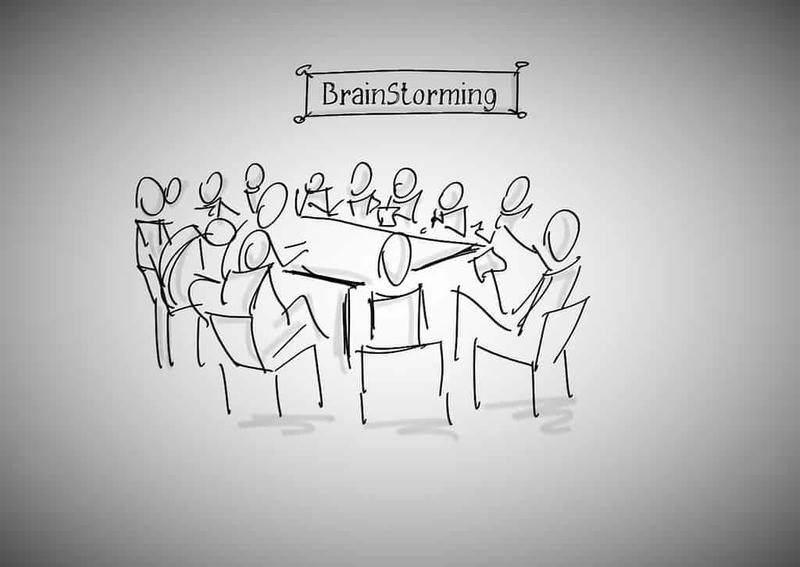
Image Source: https://www.flickr.com
Figure 2: Brain Storming among cross functional team
e) Benchmarking:
In this technique, the comparison is made between existing practices & best practices. This way most of the organizations try to explore best in class practices. And hence set their requirements to improve their current position. As we know, a market is more dynamic than ever. It is full of competition. So, to be in a race and maintain market positioning, organizations go for benchmarking. And with gap analysis, they explore the requirements and take projects.
3. Data Analysis:
Business analyst often uses these techniques. This technique is also known as Document analysis. As the name suggests, we analyze existing documents to elicit project requirements. This technique utilizes documents like:
- Business plans,
- Use cases,
- Problem or issue logs,
- Policies or procedures,
- Business rules repositories and/ or
- Market literature etc., to elicit requirements.
4. Decision Making:
Following are the techniques used in decision making for requirements collection:
a) Multi-Voting:
It is further divided into 3 categories-
- Unanimity: All group members agree to a final decision. Hence, there will be unanimity among group members about final requirements.
- Majority: Here, more than 50% of the members in the group agree to final decision.
- Plurality: The larger chunks of votes in a group qualify as a final decision. For an example, if 60% of the people agree, 25% of the members disagree and rests are neutral. Then, a final set of requirement goes with 60% votes in agreement.
b) Multi-criteria decision-making:
Here, multiple criteria are set before making a decision. These criteria are assigned different ranks. To reach final requirements, calculate these ranks. Give priority to the higher rank.
c) Autocratic decision-making:
Also called as dictatorship group decision-making. Here, only one individual defines the requirements. Who doesn’t take any consensus from others? For example, Top executive of the organization only sets the project requirements.
5. Data representation:
Following tools are used in this technique -
a) Affinity Diagram:
It is used, when we have a large number of stakeholders requirements. A similar set of requirements, we can group together under one head. Hence, we reduce the number of requirements to least possible few categories. This broadens the scope of focusing few categories rather than taking all them at once.
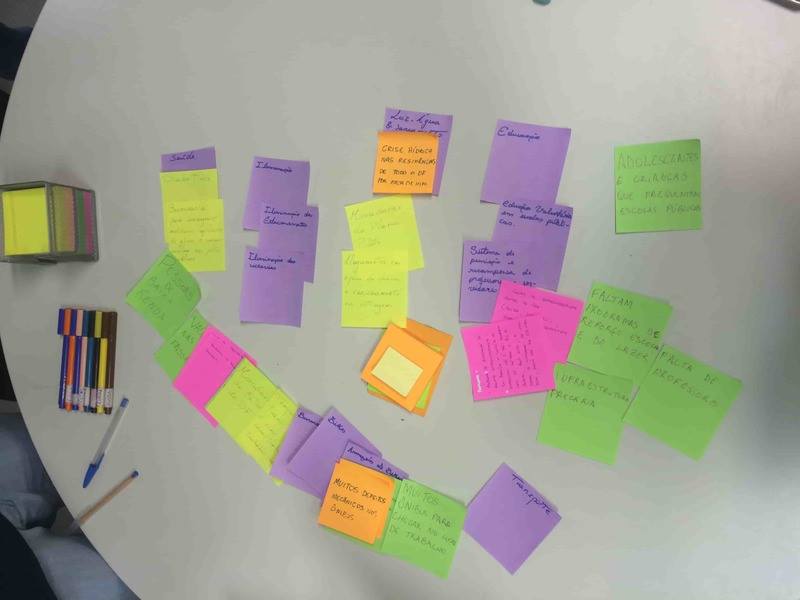
Image Source: https://commons.wikimedia.org
Figure 3: Affinity diagram generation through sticky notes
b) Mind Mapping:
Here, we wear the caps of different stakeholders. Try to map their minds and generate ideas. Thus, it’s a technique to generate a large number of ideas through the process of backtracking. A very useful technique to identify the requirements of potential customers or end users.
6. Interpersonal and team skills:
a) Nominal Group Technique:
This technique is generally used to prioritize the requirements. Here, all stakeholders take part in a brainstorming session. Generate as many ideas through brainstorming. Then rank for each idea generated. Add up all these ranks from each stakeholder to get the final ranking of each idea. These ideas are then sorted out to gather most important requirements. Higher the rank, higher the priority.
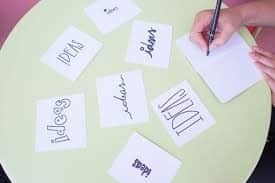
Image Source: https://www.pexels.com/photo/blur-brainstorming-business-close-up-269448/
Figure 4: Nominal Group Technique (NGT) – Idea generation
b) Observation:
Also known as a job – shadowing. Here, a potential user or group of users is observed for identifying requirements. E-commerce sites use this technique to identify the patterns of customer’s needs.
c) Joint Application Design & Development:
This technique is more focused on group dynamics & synergy. Introduced by IBM in the late 1970s, it brings stakeholders from various domains together.Commonly, referred as JAD, this technique is held in 3-4 sessions. All relevant stakeholders are invited to these sessions to gather requirements. They discuss and come to a consensus to set final requirements.
d) Quality Function Deployment:
Also known as a house of quality. This technique is preferred to generate technical requirements when stakeholders’ needs are known. Translate voice for stakeholders to identify process requirements.
e) User Stories:
Capture user’s experiences to identify different needs. Nowadays, social platforms provide many opportunities to gather user’s experiences. Examples are Twitter and Facebook etc.
7. Context Diagram:
Context diagrams exemplify a scope model. They represent a pictorial visualization of various interactions. Interactions between different users and system. Thus, they depict the steps – customers & processes take, to result in system outcomes.
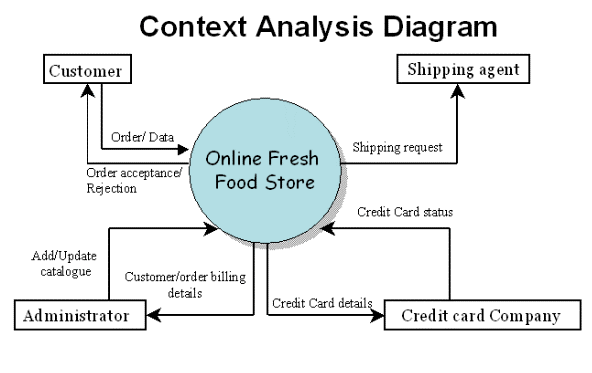
Image source. http://4.bp.blogspot.com/_na1IINYmmHI/TIdsH23TIxI/AAAAAAAAABM/Z5pj_tY-9w8/s1600/9.gif
Figure 5: Context Diagram for Online Fresh Food Store
Above figure 5, explains the context of an online fresh food store. A diagram is self-explanatory and easy to understand for all interactions.
8. Prototypes:
A model of the final product is developed based on stakeholders’ need. Now, stakeholders are asked to give their feedback on this model. Negative feedbacks are captured to identify further requirements. Positive feedbacks are retained as it is. Thus, prototype gives the flavor of the final product in advance. In this process, project managers should better use some effective prototyping tools in order to meet stakeholders’ needs. Mockplus is one of the best tools that project manager use frequently to create functional prototypes with single drag-and-drop.
Besides above, I’d like to touch upon 2 other PMP requirements collection techniques.
9. Delphi technique PMP:
What is the Delphi technique in project management? Delphi technique is used to capture stakeholder’s needs free from any bias or influence. Stakeholders with different level of influence are requested for information anonymously. All these requirements are collected and analyzed. Collected results are then shared among stakeholders. This way, it reduces the chance of not affecting any process stakeholders need for Top executive’s.
10. Facilitated Workshops:
This technique is like JAD sessions. Invite stakeholders with across different perspectives and interests in a common workshop. A facilitator helps them to bring consensus before freezing final requirements. Generally, people from cross-functional areas take part in these facilitated workshops.
So, now we understand the 10 techniques for gathering requirements & where to use them.
Tip:
Now, you have a better idea of each tool and its relevant usage. Always choose relevant and appropriate requirement gathering tools. Your ultimate goal is to capture all stakeholders’ stated/ unstated needs for the project. What does customer (s) really want in the final product? Always remember, before starting requirement collection plan, get ready with two inputs. Approved Project Charter and Stakeholder Register (Now, a part of Project documents). Because Project Charter defines you as a project manager. It mentions required project resources & most importantly, management support in favor of the project. While stakeholder register keeps you abreast of type and interest level of stakeholders. Having these two documents, now you are ready to select appropriate tools from the above list.
As a project manager, you must select the best mix of these requirement collection tools. You should try to get the best possible clarity on requirements from the stakeholder. The best approach is to collect the requirement statements. Verify them with a business case. The business case is derived from Business Documents. Business documents uncover all business needs to be required in Project. Apart from these documents, you should also refer to organizational process assets. This will give you more insights on historical information and lessons-learned repository. Focus on all collected needs during follow up meetings. And finally, use the Requirements Traceability Matrix & requirements documentation throughout the project life. Because new requirements are identified later and changes to the project happen.
Final Takeaway:
Collection of project requirements is a key process of any project. PMBOK prescribes various project management tools and techniques for collecting the requirements. But, you have to take a wise call – which tool or the mix of tool to use? Depending on the scenario, complexities, and type of requirements. Select proper tool to unearth all stakeholders’ or customer’s needs and expectations.
Learn what’s new in PMBOK v6 – Register for the Next batch near you
